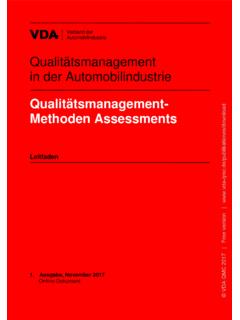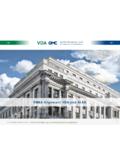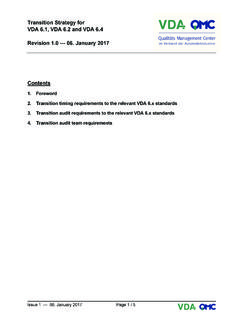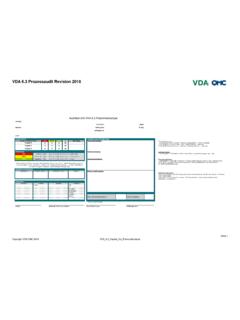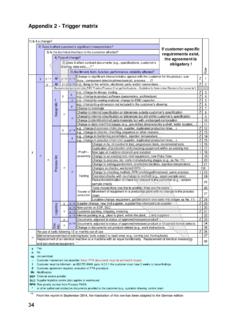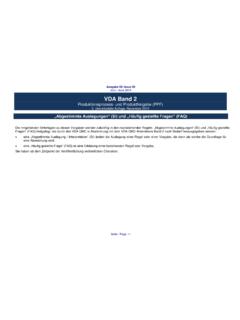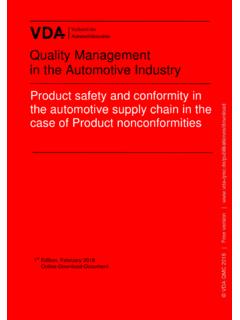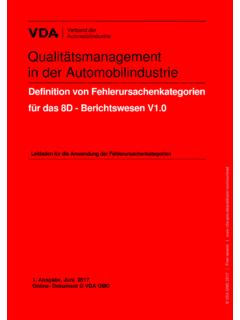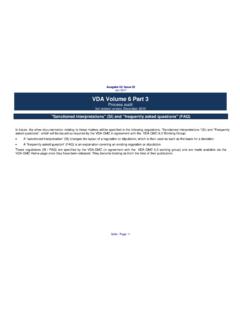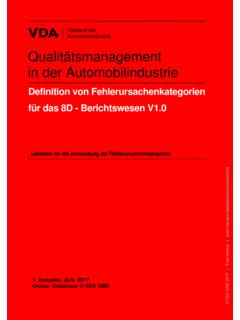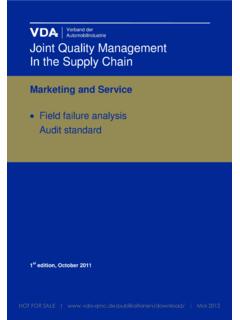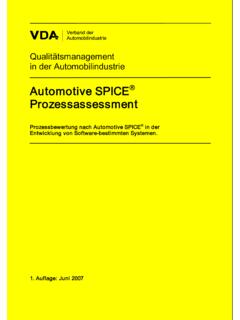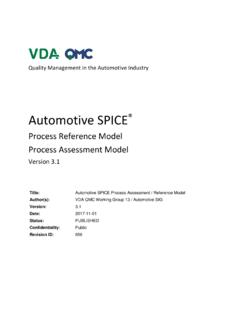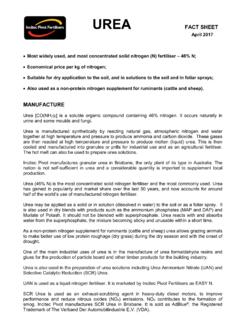Transcription of Quality Management in the Automotive Industry - VDA QMC
1 Quality Management in the Automotive Industry Assessment of Quality Management Methods Guideline 1st Edition, November 2017 Online-Document Verband der Automobilindustrie Verband der Automobilindustrie VDA QMC 2017 | Free version | Assessment of Quality Management Methods Guideline 1st Edition, November 2017 Online-document Verband der Automobilindustrie e. V. (VDA) VDA QMC 2017 | Free version | ISSN 0943-9412 Published: Nov. 2017 Online-document Copyright 2017 by Verband der Automobilindustrie (VDA) Quality Management Center (QMC) Behrenstra e 35, 10117 Berlin Germany VDA QMC 2017 | Free version | Non-binding VDA recommendations concerning standards The Association of the German Automotive Industry (VDA) recommends its members to use the following standards when implementing and upholding Quality Management systems.
2 Exclusion of liability This VDA Volume is a recommendation which is available for general use. Anyone using it is responsible for ensuring that the information is always applied correctly. The VDA Volume takes current practices into account that were valid at the time of issue. Implementation of VDA recommendations relieves no one from the responsibility for their own actions. In this respect everyone acts at their own risk. The VDA and those involved in VDA recommendations shall bear no liability. If, during the use of VDA recommendations, errors or the possibility of mis-interpretation are found, it is requested that the VDA be notified of these immediately so that any possible faults can be corrected.
3 Copyright This publication is protected by copyright. Any use outside the strict limits of copyright law is not permissible without the consent of VDA-QMC and is liable to prosecution. This applies in particular to duplication, translation, microfilming and the storing or processing in electronic systems. Translations This publication will also be issued in other languages. The current status can be requested from VDA QMC. VDA QMC 2017 | Free version | We would like to thank all participating companies and employees for their assistance in elaborating this volume. The following companies were in-volved: Adam Opel AG Benteler Automotive GmbH Otto Fuchs KG Coroplast Fritz M ller GmbH & Co.
4 KG Huf H lsbeck & F rst GmbH & Co. KG Johnson Controls Knorr-Bremse Systeme f r Nutzfahrzeuge GmbH Otto Fuchs KG Robert Bosch GmbH Schaeffler AG Thomas Magnete GmbH TRW Lucas Automotive GmbH Volkswagen AG ZF Friedrichshafen AG With the support of the Chair of Quality Science of Technische Universit t Berlin. We also extend our thanks to those people for their suggestions in devising and improving this volume. Berlin, September 2017 Verband der Automobilindustrie (VDA) VDA QMC 2017 | Free version | Index of Contents Page 1 Foreword 7 2 Scope and purpose 9 3 General description of the Assessment of QM methods model 10 Assessment system 11 Formal questions 11 Content-related questions 12 Evaluation 13 4 Selected assessment of QM methods 14 Assessing advance Quality planning QM methods 14 Failure Mode & Effect Analysis (FMEA) 14 Control Plan (CP)
5 16 Assessing statistical QM methods 17 Machine Capability Analysis 17 Process Capability Analysis 18 Statistical Process Control 19 Assessment of problem-solving QM methods 20 8D method 20 Cause - Effect diagram (Ishikawa method) 22 5-Why method (5W) 23 5 List of abbreviations 25 6 Questionnaires as a software application Methods assessments 26 VDA QMC 2017 | Free version | Index of Tables: Table 1: Scale for assessing conformity to content-related questions 12 Table 2: Explanation of the method steps of FMEA 15 Table 3: Explanation of method steps to be taken with CP 16 Table 6: Explanation of steps to be taken with SPC 19 Table 7: Explanation of steps to be taken in an 8D 21 Table 8: Explanation of steps to be taken within the cause & effect diagram 22 VDA QMC 2017 | Free version | 1 Foreword The Quality Management methods (QM methods) described in this volume are highly relevant because they focus on risk prevention, avoidance and protection, as well as on the sustained robust design of products and pro-cesses.
6 They are explained by means of examples. QM methods are ap-plied in order to systemize and compare Quality planning, control and im-provement within an organization. A QM method is only implemented opti-mally if it is applied correctly . In practice, many areas are dissatisfied about the Quality of results obtained using QM methods. Examples include a high number of failures in the field despite application of the FMEA method, or recurring claims despite use of the 8D method. Due to the fact that some QM methods are very complex, they are often applied incorrectly, incompletely or inefficiently. This volume describes an adapted procedure for assessing the Quality of application of selected QM methods.
7 The procedure can also be transferred to other QM methods. The volume is a guideline that can be used to evaluate the Quality of appli-cation of QM methods within an organization as well as the Quality of re-sults. to the Management functions. Besides being implemented as a tool to assess QM methods, it can also be used to assess Management func-tions. The volume describes a general procedure as well as a standardized valu-ation logic for assessing QM methods. The QM methods addressed are advanced Quality planning, statistical and problem-solving Quality manage-ment methods. The QM method assessments provided can be adapted to specific user requirements.
8 It is to be noted that the guideline does not compete with existing audit methods, nor is it intended to be used in conjunction with external supplier or certification audits. Existing VDA Volumes on QM methods will also not be altered or replaced. The form or application of the assessment of QM methods defined in this volume is neither binding nor mandatory. The original form may be used or modified by the organization concerned. Depending on the case at hand, VDA QMC 2017 | Free version | ( legal requirements, customer requirements, safety-related scope, etc.), both the frequency of use and interpretation of results regarding the degree of compliance may be fixed individually.
9 VDA QMC 2017 | Free version | 2 Scope and purpose In order to apply QM methods correctly, users must have sufficient knowledge about the products and processes as well as skills concerning the procedure, contents and purpose of the method. Assessors conducting the assessments are not required to have additional auditor qualifications. Assessment of QM Methods allows the user to evaluate how effectively QM methods are applied and implemented within his organization. It is not intended as a tool for approving individual documents ( an 8D report). QM methods can be assessed at all company levels, from the shopfloor right through to Management .
10 It helps the user to conduct a self-assessment, and provides the Management with facts about the awareness and sustainability of usage in the company. The benefits of application are also evaluated by taking into account the content-related Quality of the method output as well as interfaces to other processes. Assessment of QM Methods examines the input variables, application and output of the methods. The assessment results gained are intended to be used as a basis for determining individual improvements regarding the application of QM methods. Renewed assessments show the progress made over time.
